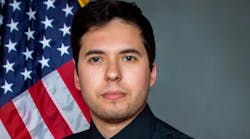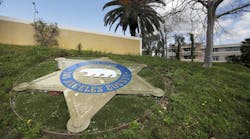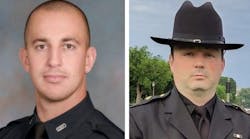The goal of pursuing excellence in a university setting is not uncommon. The University of Indianapolis (UIndy) sets itself apart from others in its partnership with the non-profit Law Enforcement and Emergency Services Video Association (LEVA).
Together, they opened the LEVA Digital Multimedia Evidence Processing Lab on the university campus in February. The university provides the space and structural support, and LEVA provides the equipment and training.
In a dedication speech, Scott Kuntz, board vice chairman of LEVA, said, "The pursuit of excellence in forensic video analysis begins here."
About 1,000 law enforcement analysts already have received LEVA training and
are familiar with LEVA's high standards. In addition to top-notch training, LEVA
students now have access to the latest forensic video technology and a new
training lab, which also can be converted to an operational lab in the event of
a national emergency.
High-tech facility goes online
LEVA first began conducting training on the UIndy campus in 2004 at the invitation of Dr. Tom Christenberry, the director of public safety education in the university's School for Adult Learning. Christenberry became familiar with LEVA when he was the chief of media and technology for the FBI Academy in Quantico, Virginia.
In October of 2006, LEVA and UIndy signed a memorandum of understanding that says the video equipment will be permanently located in the lab for at least four years.
In the past, equipment was shipped in specifically for the LEVA training. Students also brought their own systems, which were frequently disparate with the LEVA equipment.
Today the lab has the most powerful and competent video systems in the world, says Grant Fredericks, a noted forensic video analyst. The high-tech equipment found in the lab includes 20 Ocean Systems computers. Each system is configured with: dual core, dual Xeon 2.33-GHz processors; 3-GB RAM; and 1 terabyte of internal media storage. These systems are outfitted for forensic video, still image, and audio clarification and analysis.
Ocean Systems dTective, powered by Avid Media Composer, is the core processing environment for forensic video. Ocean Systems ClearID powers these systems with forensic image clarification tools such as pattern remover for fingerprint clarification. DAC QuickEnhance AS provides these units with powerful and easy-to-use forensic audio clarification tools. Additionally, these units are connected via Avid Lanshare, a 4-terabyte shared storage solution that allows teams of investigators to access and move media files. The total configuration can handle more than 300 hours of uncompressed SD (standard definition) video, as well as more than 2,000 hours of DV25.
Students attending LEVA training bring with them copies of evidentiary video from their own departments to work on as part of their training. Avid LanShare allows students to collaboratively work together on a single case.
Nineteen of the 20 workstations are for student use. The instructor's workstation has a large, flat, touchscreen that allows him to see each numbered workstation. An audio component of the multimedia teaching system from Robotel allows the instructor to communicate individually with a student or speak with the entire class. For example, if a student has a question, the student can push a button and a corresponding button will light up on the instructor's screen. The instructor can put on a headset, look at the student's workstation and communicate one-on-one.
Each of the student stations has twin, flat screen monitors, allowing 38 students to work in the lab at one time. To listen to lectures, students move to a more traditional classroom where the instructor will likely use a laptop and LCD projector.
Fredericks, who is LEVA's principal forensic video instructor and teaches
most of the lab lessons, says the ability to retain information is enhanced with
the new lab. This was proven with an increased average GPA in the first
course.
Multimedia training
Upon returning to their agencies, a significant number of LEVA graduates will immediately make a difference to their investigators, says Jan Garvin, LEVA forensic video training vice president.
"Money spent on training and equipment will pay for itself — fewer cases will go to trial because subjects will see themselves and take a plea rather than allow the jury to see the criminal act with their own eyes," he says.
LEVA training is intended for anyone who is or who will be doing video or audio forensic processing. The term "multimedia" in the lab's name means a variety of media can be examined, not only analog and digital video but still images and audio. Fredericks notes students do not need to have a forensic video system in place. If an agency is thinking about doing anything with video, including in-car cameras, or video cameras in a jail, an interview room or at crime scenes, he says this course must be a prerequisite. However, if people are only curious about video forensics and want to know what computers can do with video, Garvin says they should contact LEVA to arrange a seminar to demonstrate the value of the science.
Regardless of experience, all students begin with the basic course. Frequently, Fredericks says at the end of a course, even students who have a lot of experience comment that they've learned far more than expected. Most students return for more advanced training. Those who pass the "Basic Forensic Video Analysis and the Law" course then can apply to enter the LEVA Forensic Video Analyst Certification Program, which Garvin points out is the only program of this kind offered anywhere. In fact, he says, some agencies are making LEVA certification a job requirement for their forensic video analysts.
Since July 2000, the departments of defense and homeland security, along with federal, state and local police agencies from the United States and around the world, have received forensic video analysis training from LEVA.
Known also for developing standards and guidelines for forensic video, LEVA sets training standards.
"LEVA training is no cake walk," says Kuntz. "Ask any student who sat in front of a LEVA instructor or took a LEVA exam. Those students who pass and receive a course certificate know they have accomplished something special and they should be proud of that."
At the first training in the new facility, 64 students attended the week-long "Basic Forensic Video Analysis and the Law" course.
Among them was Ernie Van Der Leest, a criminal investigator with the district attorney's office in Tarrant County, Fort Worth, Texas, where one of the regional International Association of Chiefs of Police forensic video labs will be located.
Van Der Leest, who had never done forensic video analysis previously, said the greatest benefit to him was learning the capabilities of forensic video. Without hesitation, he recommends the training to others.
"The facility and equipment is excellent," he says. "The instructors are extremely knowledgeable."
Garvin echoes the comment made by Van Der Leest, saying instructors are essential to good training.
"Any business could mirror this facility and call it something similar,"
Garvin says. "But, the one thing no other venue will acquire is the superbly
competent, skilled and dedicated instruction team. Each instructor is a widely
respected expert who has attained the knowledge and experience to collectively
represent the best there is in doing what they do."
Prepared graduates
Some LEVA graduates have gone on to become LEVA trainers. Overall, LEVA graduates have assisted investigators in thousands of criminal cases. Some processed video evidence from 9/11.
"The readiness arsenal of the United States always needs to be re-evaluated and updated as new technology evolves," Kuntz says.
In the event of a national crisis, the LEVA lab can be secured and used as a fully operational video processing center.
Thousands of video assets could be brought in, and to process the evidence, a
roster of LEVA-trained forensic video analysts is ready to be called upon. Until
there is a need for the lab to become operational, its primary role remains
training.
Future training
Initially, six LEVA courses have been selected to be conducted during this first year. Besides the basic- and intermediate-level forensic video analysis courses, others include:
- "Basic Forensic Audio Analysis" was made possible by Digital Audio Corp., which donated $60,000 worth of its QuickEnhance audio clarification tool.
- "Photographic/Video Comparison" focuses on the science of comparing known objects, vehicles, clothing and humans with CCTV images of questioned objects, vehicles, clothing and humans.
In the future, LEVA will be scheduling more classes, introducing additional topics and expanding its instruction cadre. In 2008, classes will be added for law enforcement video producers. The organization also is planning to develop deployable instruction to reach those unable to attend classes at UIndy.
"LEVA needs to remain ahead of the learning curve to not only meet the demand — but anticipate it," Garvin says.
When LEVA is not using its permanent lab, it will be used by UIndy faculty and students from various disciplines. But first, the faculty must be trained on the equipment and develop new programs.
"We're very excited about this partnership," says Christenberry. "What LEVA is doing is tremendously important. We're also excited about the potential use of this lab by our faculty and students — to help them put together better courses, better curricula so that students are better prepared once they leave the confines of the university."
Long term, Christenberry would like to see junior- or senior-level forensic courses in the lab.
With increased awareness of forensic video, comes increased demand for more training.
Fredericks talks to police executives about the benefits of forensic video when he conducts training at the FBI Academy.
"We stress that there's a huge opportunity with forensic video, but it's the responsibility of every police executive to ensure that their officers and civilian staff are trained with the tools they use and are trained to do their jobs," he stresses. "Processing video evidence is a scientific process — just like fingerprints, DNA and ballistics. The process should not be left to someone who doesn't understand video and has not been trained because he will misinterpret the evidence."
When video analysts are properly trained, he says then agencies will realize the benefits very quickly to their agency: faster results, more reliable information, accurate investigations, quicker resolutions in court, less overtime, less court time and a more professional agency overall.
Note: For more information about LEVA forensic video training, contact LEVA Vice President Jan Garvin at [email protected].
Rebecca Kanable is a freelance writer living in Wisconsin. She specializes in law enforcement issues and can be reached at [email protected].


